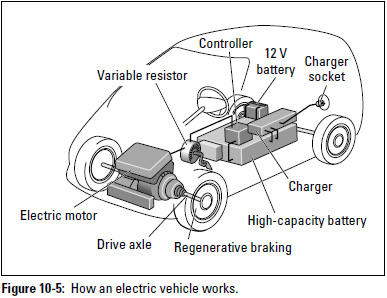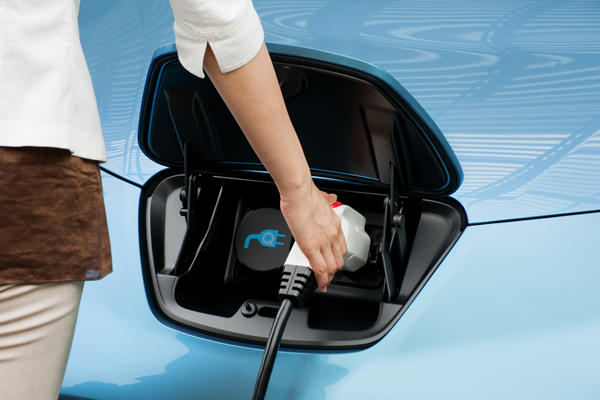Electric Vehicles (EV)
Many people picture electric vehicles (EVs) as glorified golf carts powered by 12-volt batteries, with limited range and speed. They assume the vehicles are great for local driving but can't contend with traffic on busy streets or highways. However, as larger and more powerful EVs with a wider rangeappear, this image is no longer accurate.
Modern EVs accelerate more powerfully, have competitive top speeds, seat at least five passengers, and can be recharged easily by their owners. They can haul big loads and climb steep hills with relative ease. As with plug-in hybrids, storage-battery technology has been slow to achieve the breakthrough needed to let EVs store enough energy to give them the extended range to compete with vehicles powered by conventional engines and to recharge fast enough to compete with just driving into a filling station. Major efforts are being made to improve storage batteries and cold-weather performance. EVs powered by fuel cells have the potential to overcome these drawbacks. EVs are already popular in Europe, and EVs with enhanced performance are featured in car shows throughout the U.S.
Electric vehicles utilize a powerful electric motor and a large capacity battery to store the energy and deliver it to the motor on-demand (see in Figure 10-5). They also have the same 12-volt battery as other vehicles to keep electric devices working when the motor that drives the vehicle isn't in use. Otherwise, EVs have the same steering, suspension, and other gizmos as conventional vehicles and use the same regenerative braking system to generate electric current when the brakes are applied. Because EVs don't have a conventional fuel system, a dashboard display tells you when the vehicle is generating, storing, or using electricity and how far you can go without recharging the battery.

Except for a small fan that may kick in for a short time when you start the car, EVs are silent when you start, drive, and come to a stop. How hard you step on the accelerator tells a computerized controller how fast you want to go. The controller can shut down the motor to prevent it from operating at too high a speed and deliver just the right amount of energy to the motor. The more power the motor receives, the faster it can turn the drive axle that transmits the power to the wheels. The power is transmitted to the drive axle directly because an electric motor delivers full torque at all times, so a transmission isn't necessary. Despite this different configuration, you drive an EV in the same way as you do a conventional vehicle.
|
Tragic History of the EV Although electric vehicles (EVs) were popular in the early 1900s, they were eclipsed by petroleum-powered cars. The first popular EV was the EV-1. General Motors produced and leased about 1,200 from 1997 to 1999. In 2004, when the last lease expired, although there was a waiting list of about 35,000, GM said that EVs weren't popular enough to continue production. Over the protests of the lessees, who were willing to buy them, GM recalled the EV-1 and destroyed most of them. For undisclosed reasons, the Smithsonian even took their EV-1 off display a few years later! The documentary film "Who Killed the Electric Car?" delves into this controversial story. The demand for zero-emissions vehicles (ZEVs) has now renewed interest in a new generation (pardon the pun) of affordable electric vehicles. |
Recharging the battery on an electric car is usually cheaper per mile than buying gasoline, and because it's a zero-emission vehicle (ZEV) it doesn't pollute the air as vehicles that run on fossil fuels do. However, plugging into power from public utilities generated from fossil fuels presents the same problems as with plug-in hybrids. Happily, the positive developments for remedying this apply to EVs as well. Fuel cells may bethe deciding factor in whether EVs become the "greenest" way to go.
Regenerative Brakes
Hybrids and other energy-efficient vehicles have regenerative braking systems that generate electric power to help keep the batteries charged. When the driver applies the brakes, the electric motor turns into a generator, and the magnetic drag slows the vehicle down. For safety, however, there is also a normal hydraulic braking system that can stop the car when regenerative braking isn't sufficient. There's no difference in maintenance or repair except that the brake pads tend to last much longer because they don't get used as much. In fact, if you drive a hybrid in a moderate manner, you almost never actually use the disc brakes on the wheels and may be able to go the life of the car without changing pads. The big difference is that regenerative brakes capture energy and turn it into electricity to charge the battery that provides power to an electric motor.
From Auto Repair for Dummies, copyright © 2009 by Wiley Publishing, Inc., Indianapolis, Indiana. Used by arrangement with John Wiley & Sons, Inc.










